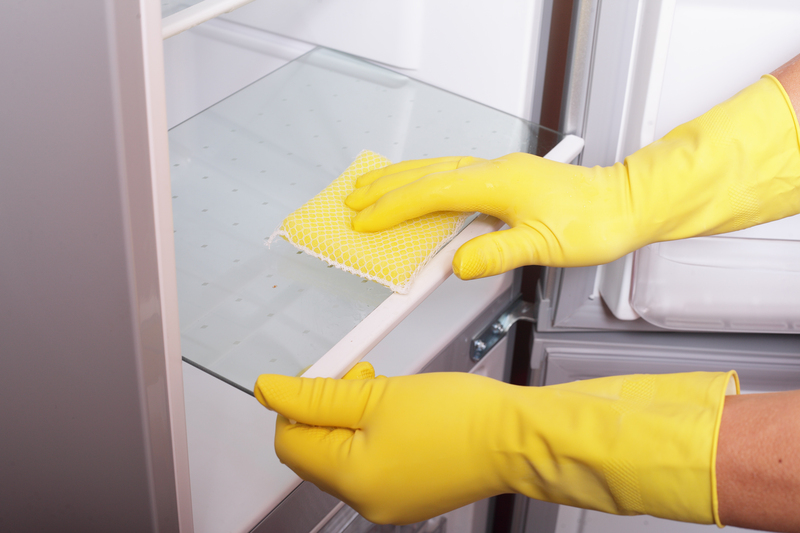Redefine Curtain Cleanliness with Expert Insight
Posted on 02/09/2025
Redefine Curtain Cleanliness with Expert Insight
Curtains do far more than frame your windows--they set the ambiance, filter light, provide privacy, and often become a stylish centerpiece in your rooms. However, there is a crucial aspect of home maintenance that many overlook: curtain cleanliness. If you haven't thought about how those gorgeous fabrics in your home could impact air quality, health, and aesthetics, it's time to take a closer look. With expertise and advanced strategies, you can redefine how you approach curtain cleaning, ensuring a fresher, healthier, and more beautiful living space.
Why Curtain Cleanliness Matters
- Air Quality: Curtains are notorious for trapping dust, pollen, pet dander, and airborne pollutants. If left uncleaned, they can degrade the indoor air quality significantly.
- Allergy Relief: Allergens like dust mites thrive in fabric folds. Clean curtains can drastically reduce allergic reactions, sneezing, and irritation.
- Prolonged Fabric Life: Dirt and pollutants weaken textile fibers. Consistent, proper cleaning preserves curtain quality and prevents unnecessary wear and tear.
- Visual Appeal: Clean, fresh-smelling curtains simply look better and uplift room decor.

Understanding the Varieties: Curtain Types and Their Cleaning Needs
No two curtains are exactly the same. Different fabrics, linings, and construction methods call for different cleaning approaches. Here's an in-depth view, allowing you to redefine the cleanliness of your curtains based on expert recommendations:
Cotton & Linen Curtains
- *Benefits*: Breathable, casual, and easy to match.
- Expert Advice: Most cotton and unlined linen curtains are machine washable. Use gentle cycles and mild detergents to avoid shrinking or fraying.
- Pro Tip: Air dry instead of using a dryer to retain fabric shape and prevent weakening of fibers.
Velvet and Heavy Drapes
- *Benefits*: Luxurious, dramatic presence, superior insulation.
- Expert Advice: These require special care. Avoid machine washing--opt for professional dry cleaning to prevent distortion or color fading.
- Insider's Note: Between cleanings, use a handheld vacuum or a soft brush attachment to remove surface dust.
Sheer and Synthetic Curtains
- *Benefits*: Elegant, light-diffusing, often child and allergy-friendly.
- Expert Advice: Most synthetic sheers can be gently machine washed or even hand washed. Avoid heavy spinning and promptly hang to drip dry.
- Insider Tip: Wash sheers in cold water to minimize wrinkling and preserve their diaphanous look.
Specialty Curtains and Mixed Fabrics
- *Benefits*: Custom aesthetics, designer patterns, unique blends.
- Expert Advice: Always refer to manufacturer's care instructions. Professional cleaners can identify blends and advise on safe cleaning methods.
- Important: Test cleaning solutions on a hidden patch to avoid color running or dullness.
Common Curtain Cleaning Myths Debunked
Let's challenge some popular misconceptions that often lead to ruined curtains or half-cleaned results:
- "Curtains only need to be cleaned when visibly dirty":
- Fact: Invisible dust, allergens, and bacteria accumulate quickly. Experts recommend a routine every 3-6 months.
- "Vacuuming alone is enough":
- Fact: While vacuuming helps with surface dust, it does not eliminate deep-seated debris or microbial growth.
- "All curtains can handle machine washing":
- Fact: Many fabrics and linings, especially silks, velvets, and interlined curtains, require specialized care to prevent irreversible damage.
- "Curtains don't affect allergies":
- Fact: Clean curtains can drastically improve your indoor environment for allergy sufferers, especially when maintained by expert methods.
The Expert's Step-by-Step Guide to Superior Curtain Cleanliness
Professional curtain cleaners employ a combination of techniques and tools for optimal results. Here's a breakdown, so you can bring expert curtain cleaning wisdom into your home:
- Assessment: Check fabric type, manufacturer label, presence of stains, linings, and attachments before starting a cleaning regimen.
- Preparation: Remove hooks, weights, and detachable linings. Shake out loose dust outdoors before washing or vacuuming.
- Pre-Treatment: Spot clean difficult stains using fabric-appropriate solutions. For stubborn spots, consult with a curtain specialist.
- Washing:
- *Machine Washable Curtains*: Use a gentle cycle, cool water, and mild detergent.
- *Hand Wash*: For fragile textiles, soak and gently agitate. Never wring or twist.
- *Dry Cleaning*: For silks, velvets, and lined curtains, always choose professional dry cleaning services.
- Drying: Air dry whenever possible. Hang curtains to drip dry, ensuring good airflow to prevent mildew. Avoid direct sunlight on delicate colors to minimize fading.
- Ironing & Steaming: Iron on a low-heat setting or use a garment steamer while the curtain is still slightly damp. Test a small corner first.
- Rehanging: Re-attach hooks and linings, then rehang. Ensure curtains are stretched flat to maintain shape and drape.
Bonus: Freshening Curtains Between Deep Cleans
- Vacuum once a week, working from top to bottom using a soft brush attachment.
- Use a lint roller to lift pet hair and surface dust.
- Mist lightly with a fabric spray containing antibacterial properties for a fresh, clean scent.
- On a dry, breezy day, hang curtains outside for 1-2 hours to air out and eliminate odors naturally.
Innovative Curtain Cleaning Techniques from Industry Experts
Home cleaning is evolving--and so are curtain care standards. Discover how professionals redefine curtain cleanliness with the latest technologies and best practices:
1. Ultrasonic Cleaning
This advanced method employs high-frequency sound waves in a water bath, shaking loose even deeply embedded dirt and allergens. It's especially effective for delicate fabrics and intricate designs. Requires professional equipment but delivers exceptional cleanliness.
2. Steam Cleaning
A favorite for heavy drapes and velvet curtains, steam cleaning sanitizes while lifting grime--no harsh chemicals needed. Use a handheld garment steamer for spot cleaning between deep cleans.
3. Eco-Friendly Solutions
The move toward sustainability has introduced plant-based and chemical-free cleaning agents. Experts recommend hypoallergenic products, especially for children's or allergy-prone rooms. Enzyme-based cleaners also break down stains without damaging fabric structure.
4. Anti-Bacterial and Anti-Allergy Treatments
Some cleaning services now offer specialized treatments that coat your curtains with protectants to repel dust mites, mold spores, and bacteria. This approach is ideal for homes with pets, allergies, or high humidity.

Pro Curtain Maintenance Tips to Prolong Freshness
- Rotate curtains between rooms to even out sun exposure and fading.
- Use tiebacks or holdbacks instead of touching the fabric frequently, reducing oil and dirt transfer from hands.
- Check for moisture or dampness near windowsills--address immediately to avoid mildew and staining.
- Perform a regular sniff test--musty smells mean it's time for a clean, even if stains aren't visible.
When Should You Seek Professional Curtain Cleaning?
Despite your best DIY efforts, some scenarios call for a professional touch. Consider expert help if:
- Your curtains are made of luxury fabrics like silk, velvet, or wool blends.
- There are stubborn stains or persistent odors you can't remove at home.
- Volume or size makes cleaning unmanageable (e.g., extra-long or heavy theater drapes).
- You need anti-allergy, anti-microbial, or fire-retardant treatments applied.
- Your manufacturer's warranty recommends or requires professional cleaning.
Professional curtain cleaning not only delivers a higher level of curtain hygiene but ensures your valuable textiles are protected and your indoor air remains pristine.
Frequently Asked Questions
How often should I be cleaning my curtains?
Experts recommend a thorough clean every 3-6 months for most homes. For those with allergies, pets, or high pollution, opt for every 2 months and add in-between freshening weekly.
Can I wash blackout curtains?
Some blackout curtains tolerate gentle machine or hand washing, while others have coatings that degrade with water or heat. Check manufacturer instructions carefully and when in doubt, choose professional cleaning.
Are fabric sprays a substitute for cleaning?
No--while they freshen and kill some odor-causing bacteria, fabric sprays do not remove soil, stains, or heavy allergens. Combine them with regular washing or dry cleaning.
What about mold and mildew?
Mold and mildew are best treated immediately. First, take curtains outdoors and brush off spores, then wash or steam-clean as appropriate. For persistent issues, consult a professional to prevent health risks.
Final Thoughts: Elevate Your Standards and Redefine Curtain Cleanliness
Your home and your health deserve careful attention to the seemingly small details. By embracing these expert insights and adopting professional-level curtain cleaning methods, you can transform your living environment--improving allergy control, air quality, and the visual impact of your rooms.
Don't wait for visible dirt or odors to dictate your routine; instead, proactively choose to redefine curtain cleanliness and enjoy a fresher, healthier, and more beautiful home.
Trust your instincts, seek professional help when needed, and remember: a curtain's cleanliness is the silent ambassador of your entire home's hygiene.


